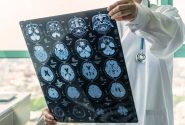(HealthDay News) — (Tasrir) — According to the U.S. Centers for Disease Control and Prevention, nearly 6 million Americans live with Alzheimer’s disease.
In this article, experts shed light on the signs of both early and late Alzheimer’s, providing valuable information to help individuals, families and caregivers recognize the warning signs and seek timely medical intervention.
Early Alzheimer’s symptoms
When it comes to Alzheimer’s disease, recognizing the early signs is crucial for timely intervention and effective management.
“The red flag is if it’s happening consistently and is paired with a change in the person’s ability to function,” Dr. Magdalena Bednarczyk, a Rush University Medical Center geriatrician, said in a recent article. “When a patient comes to me for an evaluation, it’s usually because family and friends have noticed uncharacteristic or concerning behaviors, not just memory issues.”
According to Bednarczyk and the Alzheimer’s Association, if you notice any of the early warning signs of Alzheimer’s in yourself or a loved one, especially if there is more than one, reach out to your primary care physician.
- Memory loss: According to the U.S. National Institute on Aging, memory problems are typically one of the first signs of the disease. The most common symptom of early Alzheimer’s is recent memory impairment. “People who have a normal sort of memory impairment — or memory impairment you see with aging — will typically remember what they’ve forgotten within a couple of minutes,” Dr. Angela Morriss, division director of general and hospitalist medicine with UC Health in Ohio, said in a recent article.
- Difficulty with problem-solving: Alzheimer’s may affect a person’s ability to develop and follow a plan or solve problems. Simple tasks, such as following a recipe or paying bills, are challenging.
- Confusion of time and place: People with early-stage Alzheimer’s often lose track of dates, seasons, and the passage of time. They may also have difficulty understanding where they are or how they got there.
- Changes in vision and spatial awareness: Alzheimer’s can impact visual perception, leading to difficulty judging distances and determining color or contrast. This may result in problems with reading, driving, or navigating familiar surroundings.
- Decreased or poor judgment: A person with Alzheimer’s may exhibit changes in judgment or decision-making abilities. They may make poor financial choices, neglect personal hygiene, or show decreased attention to grooming and appearance.
- Withdrawal from social interactions: Early-stage Alzheimer’s can bring about noticeable changes in social behavior. Individuals may start withdrawing from social activities, hobbies and conversations, showing a reduced interest in once-enjoyed interactions.
- Mood and personality changes: Alzheimer’s can trigger shifts in mood and personality, leading to increased irritability, anxiety or depression. People may become easily upset, suspicious, or exhibit uncharacteristic mood swings.
- Difficulty with speech and writing: Expressing thoughts and following or joining a conversation may become challenging for those with Alzheimer’s. They might struggle to find the right words or follow a train of thought.
- Mental confusion: Confusion and disorientation are common in individuals with Alzheimer’s, especially in unfamiliar or complex environments. They may forget their location, the current date, or the purpose of familiar objects.
- Aggression and agitation: In some cases, Alzheimer’s can lead to increased aggression, restlessness or irritability. This can be distressing for the individual and their caregivers, requiring patience and understanding.
Signs of moderate to severe Alzheimer’s symptoms
Witnessing the decline of a loved one’s health due to Alzheimer’s disease can be an emotionally challenging journey. As the condition progresses from the early stages, the symptoms of Alzheimer’s become more pronounced, necessitating increased support and specialized care.
Now, here are the signs associated with moderate to severe Alzheimer’s, drawing insights from the National Institute on Aging.
- Memory loss worsens. Memory loss becomes more severe, encompassing not only recent events, but also significant aspects of personal history, and recognition of family and friends.
- Difficulty with communication. Expressing thoughts and understanding conversations becomes increasingly challenging. Individuals may struggle to find words, follow discussions or initiate coherent speech.
- Confusion and disorientation. Moderate to severe Alzheimer’s often leads to heightened confusion and disorientation. Individuals may struggle to recognize familiar surroundings, including their homes or neighborhood.
- Difficulty with basic tasks. Everyday tasks such as dressing, bathing and grooming become progressively more challenging. Individuals may require assistance or supervision to perform these activities safely.
- Behavioral and mood changes. Changes in behavior and mood can become more pronounced. Individuals may exhibit increased anxiety, agitation, aggression or apathy. Sleep disturbances and nighttime wandering may also occur.
- Hallucinations and delusions. Some individuals with advanced Alzheimer’s may experience hallucinations, seeing or hearing things that are not there or develop unfounded beliefs or suspicions (delusions).
- Weight loss and decline in physical health. As the disease progresses, individuals may experience unintentional weight loss and a decline in overall physical health. Difficulties with eating, swallowing and coordinating movements may arise.
- Inability to recognize loved ones. Severe Alzheimer’s may result in the inability to recognize close family members and friends. This can be distressing for both the individual and their loved ones.
- Loss of ability to perform self-care. Individuals may become utterly reliant on others for activities of daily living, including feeding, toileting and mobility.
- Decline in cognitive function. The cognitive decline becomes significantly pronounced, affecting multiple domains of thinking, including memory, attention, problem-solving and reasoning abilities.

















